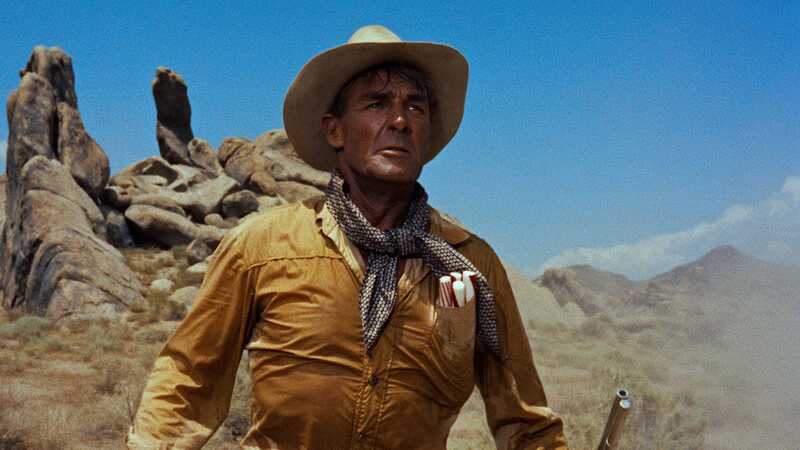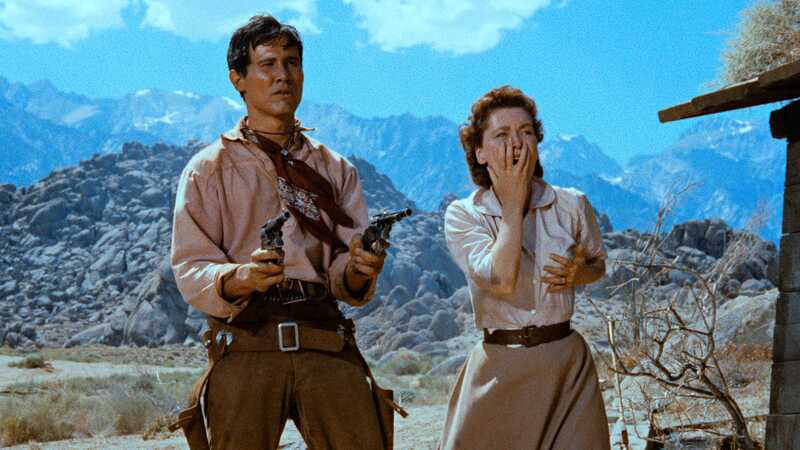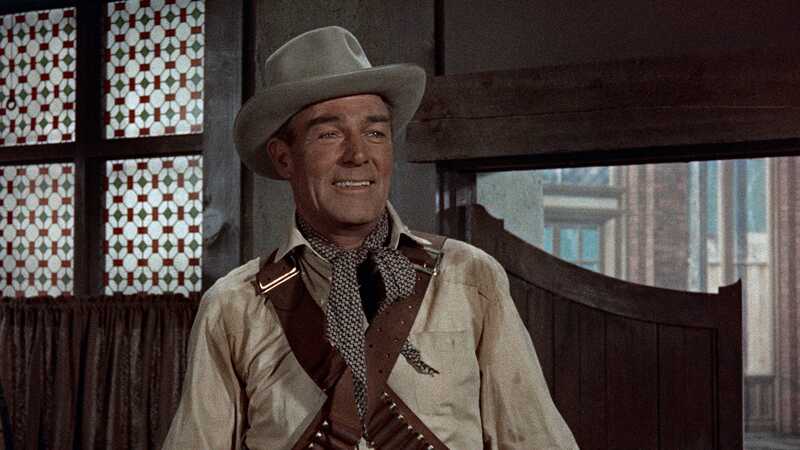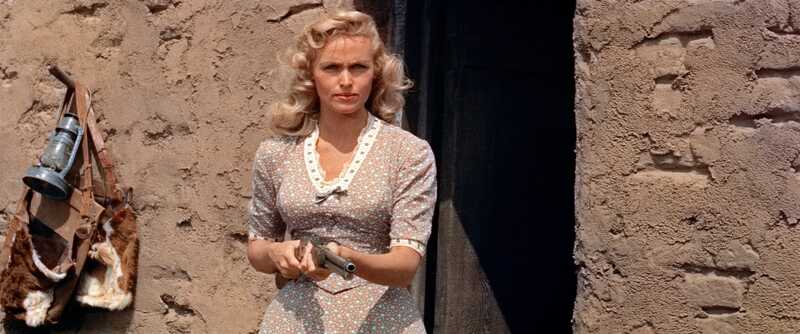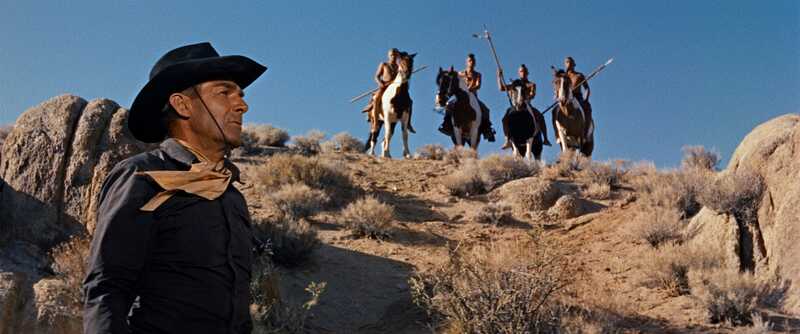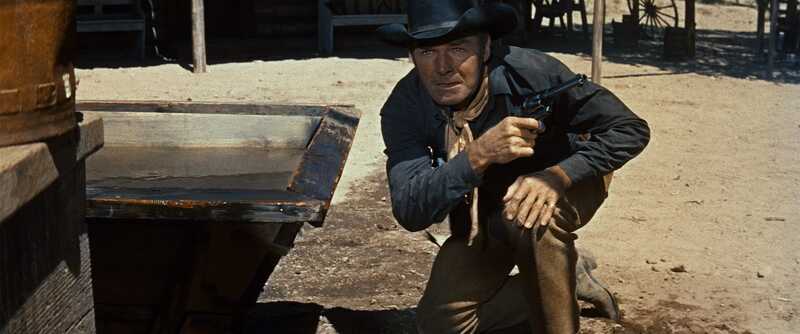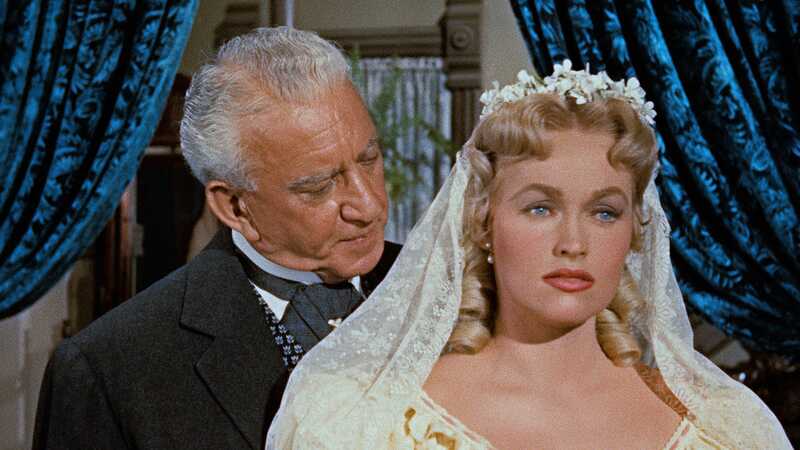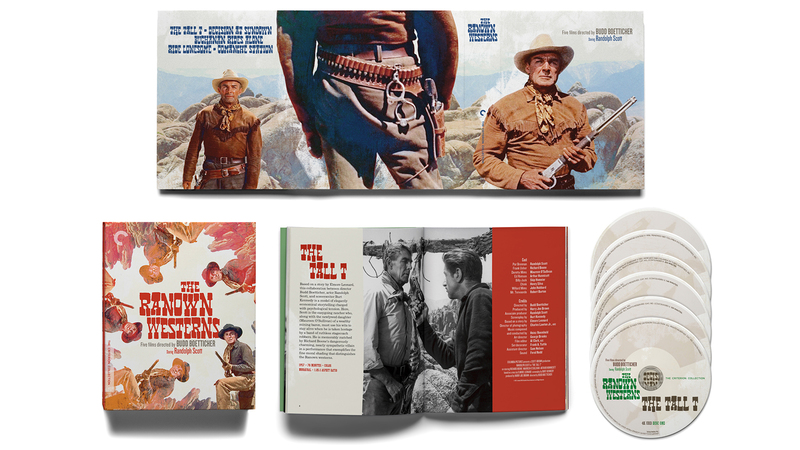THE RANOWN WESTERNS: FIVE FILMS DIRECTED BY BUDD BOETTICHER 4K Review: Riding on Criterion
Randolph Scott Lee Van Cleef, James Coburn, Henry Silva, and Claude Akins star in these five outstanding films.
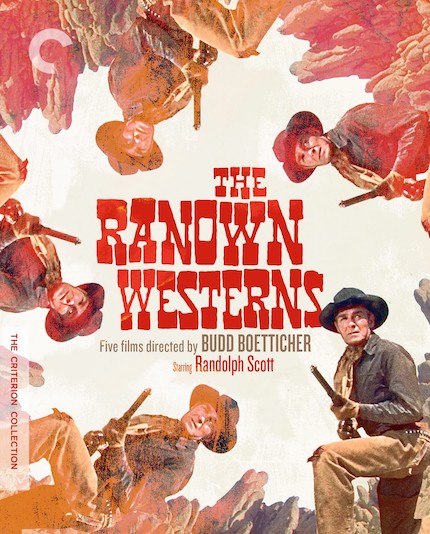
It’s the latter end of the 1950s, the greatest movie decade. Director Budd Boetticher and leading man/established Western legend Randolph Scott have teamed up for a run of uncompromising, unforgettable films. All in all, they would make seven films from now.
In their raw starkness, limited scale, and singleness of individual purpose, these movies each invariably hit their mark. Despite their intended pedigree as B-movie programmers -- every one of them has no fat on ‘em whatsoever -- they all, to narrow, varying degrees, range in quality from “tautly solid” to “all-time great.”
Randolph Scott ventures into an American Old West of greying morality with the hair to match in what would be loosely known as the Ranown cycle of Westerns, a batch of films that have taken on a renown all their own. Blazing Saddles’ sudden chorus singing Scott’s name in exhalation is nowhere to be heard as the man/the legend rides into the territory of rocky, lonely Lone Pine, California. (As he does every time). Yet, after becoming acquainted with the leading man of the five top-tier classics contained in Criterion’s 4K & Blu-ray box set of Ranown Westerns, most anyone would be compelled to sing the praises of Raaaanndolph Scott!!!
Even in his time, though, Scott’s enduring appeal eluded some. Case in point: when John Wayne was looking to opt out of starring in Boetticher’s Western 7 Men from Now (1956), which was being made by his own production company, Batjac, he reportedly suggested, “How ‘bout Randolph Scott? He’s through.”
Meaning, Scott could not only do the job well (and he does), but he could also likely easily be wrangled for the project. While the quote has taken its place in cinema lore, the esteemed film historian Jeanette Basinger, on her 2008 commentary track for Boetticher’s The Tall T (1957), points out that in the early 1950s, Scott ranked quite comfortably on the list of top actors at the box office.
Nevertheless, Scott and producer Harry Joe Brown set out to create a series of solidly crafted B-Westerns, each starring Scott and directed by Boetticher. The veteran director’s straightforward visual approach proved perfect for the material, so often walking the line between established genre tropes and a more contemporary depth.
Eventually Scott and Brown got around to making their collaboration even more official by founding Ranown Productions. (Randolph Scott + Harry Joe Brown = Ranown). Though the entire seven-film run of these Westerns are commonly referred to as “Ranown” (including this set’s title), in actuality, only the last two of the set, Ride Lonesome and Comanche Station, are officially Ranown productions. But they’re all really good.
The filming of each one only lasted 13 days or thereabouts, and their running times are only about 75 minutes or so. Screenwriter Burt Kennedy, who would go on to direct Westerns of his own, said his goal for these screenplays is to “play a real small story against a large background.” Done. Kennedy didn’t write all five of the films contained in Criterion’s set Ranown Westerns: Five Films Directed by Budd Boetticher, but he did write the most revered ones.
The Tall T typically towers as the triumph of the bunch… even with that title. With a screenplay by Burt Kennedy based on a short story by Elmore Leonard called “The Captives,” The Tall T is the story of former ramrod looking to make a go on his own (Scott) and the well-off wife (Maureen O’Sullivan) of a cowardly money man who are taken captive in the God-forsaken middle of nowhere.
On her audio commentary track, film scholar Jeanine Bassinger tells us: “In a Budd Boetticher Western, the thing we see first is the thing that matters most. In this case, it’s the desolate landscape of Lone Pine.” Basinger’s commentaries are always to be savored, and this is one of her greats.
The first 15 or so minutes of The Tall T play like an altogether different movie. Chirpy music and neighborly ethos simply dominate. It’s all just so nice. But The Tall T is not nice. When the villains are revealed and the captives are taken, there is a revelatory moment that no viewer is likely to ever forget. That look on Randolph Scott’s face… a close-up has rarely been so perfectly earned, so expertly implemented. The villains are memorably played by Richard Boone (the mastermind), Henry Silva (the psychopath), and Skip Homeier (naively in over his head with these other two, but there’s no going back now).
----------
The next film, 1957’s Decision at Sundown, is a classic example of a film that pulls off presenting itself as one thing, but then being about another. Though Boetticher himself all but disowned it, feeling that it did a disservice to the impeccable, noble image of Randolph Scott, the film persists with an unmistakably subversive power that was rare in its time. (Boetticher also dismissed Westbound, which, along with 7 Men from Now, are the qualifying films not included in this set. Which is really too bad).
Scott is Bart Allison, a despondent traveler who makes his way to the sleepy town of Sundown. From the outset, it’s quite clear that Allison has it in for wealthy skunk Tate Kimbrough (John Carroll), who is about to marry the elegant Lucy Summerton (Karen Steele). Kimbrough, though, has a history of womanizing, including an affair with Scott’s wife. According to Allison, Kimbrough’s duplicity ultimately led her to take her own life. There is, however, much more to the story. And it ain’t pretty. By the end, no one has much to smile about.
Decision at Sundown is one of the most disregarded films of this lot, though I challenge that standing. It gives us a chance to see Scott doing something very different and pulling it off with searing resonance.
Buchanan Rides Alone (1958), meanwhile, finds Scott’s character, Tom Buchanan, in an altogether chipper mood. Riding (alone, of course) into the aptly named aggressive town of Angy, Buchanan sports a loaded gun-belt, prominent bullet bandoliers, and nice big smile. Though this lead-adorned stranger is only a guitar short of resembling a singing cowboy act, the sheriff of Angy wants him gone, gone, gone.
Soon enough, we find out that he’s also packing about $2000 on his person, funds he intends to use to settle into a ranch of his own. It doesn’t take long to learn that the Angy powers that be -- corrupt, every one of ‘em, you can tell right off by their blustery proclamations of “law and order!!” -- have a good thing going for themselves, and don’t want some salty outsider coming in to screw it up.
That, though, is exactly what happens. Buchanan, with his stuffed money-belt further complicating things, just happens to be on hand when a vengeance-seeking young vaquero, Juan De La Vega (Manuel Rojas), turns up and kills the powerful town judges’ (Tol Avery) grown son. From there, Buchanan and Juan find themselves two of a kind, being hanged, tried, jailed, robbed, chased, and held at gunpoint (in that order, roughly) together. And Buchanan ain’t so alone anymore.
Based on the quite recent 1956 novel The Name's Buchanan by Jonas Ward, with its screenplay adaptation credited to Charles Lang but actually by Burt Kennedy, Buchanan Rides Alone has the distinction of being the only one of these “Ranown” projects shot by Boetticher’s preferred cinematographer, Lucian Ballard (who’s best known for later shooting much of Sam Peckinpah’s finest work). Adding to its slight variances in look and tone is the fact that it was shot in Arizona, not Lone Pine.
Not uncommonly in these films, we more or less start in the middle of something. Yet, for 1959’s Ride Lonesome, it’s an ideal beginning. This, after all, is when “Scott-Brown Productions” formally became “Ranown.” By this point, the science of creatively mining this territory had become an exact science, though with plenty of elbow room for creative shifting. With Ride Lonesome, Boetticher, Scott, Brown, and Kennedy once again strike gold.
Scott plays Ben Brigade, a roving bounty hunter with an agenda we learn to be shockingly personal. Early on, he finds himself at a forgotten stagecoach way station that turns out to be occupied by the rifle-wielding wife of the long-absent station manager, Mrs. Carrie Lane (Karen Steele). Perhaps too attractive for the part, Steele nevertheless exudes the spirit of a lone woman unafraid to look out for herself. A good thing, too, as bad guys abound.
Pernell Roberts plays Sam Boone, another self-assured man’s man, a complex guy with a bloody agenda of his own, but also a code of honor of sorts. Boone is a lusty man with hungry eyes for Mrs. Lane, and a streak of white supremacy. Other characters of varying morality are played by a young Lee Van Cleef, James Coburn in his debut role, and Roscoe P. Coltrane himself from The Dukes of Hazard, James Best.
As things converge at one of the most ominous hanging trees in movie history, Ride Lonesome strikes its climactic peak. Once again, we see shades of Randolph Scott that 1950s audiences may not have expected. Yet, of all the Scott-Brown cycle, this was Boetticher’s favorite, per historian Jeremy Arnold’s commentary track for the title. And with fine reason.
As Scott says, “She ain’t ugly.” Cinematographer Charles Lawton Jr. more than makes sure of that, photographing the film with an inescapable sunniness, though it’s said that there are no “directors of photography” on a Boetticher picture, because: “There’s only one director on a set, and that’s the director!,” the director said.
Finally, in 1960, the series arrives at the end of the line, Comanche Station. Written by Burt Kennedy, the film co-stars TV’s future Sheriff Lobo, Claude Akins, as Ben Lane, the head of this film’s pack of unscrupulous wrongdoers. Nancy Gates plays Nancy Lowe, a woman kidnapped by Comanches until Scott’s character, Jefferson Cody, frees her.
Did he do it for the $5000 “dead or alive” reward her husband has placed on her? Whatever the case, Lane prefers to deliver her dead while Cody fights to keep her (and himself) alive.
Cody and Lane have crossed paths in the past, making the latter vengeful towards the former. This is the Boetticher film of this series with the most "Indians" and is also the one to make the finest use of the dense and towering “Alabama Hills” boulders in Lone Pine.
Comanche Station starts and ends amid these memorably massive formations, visually complimenting its thematic elements of trust and traumatic situations. It’s telling of the time the film was made, circa 1960, that the unspecified but strongly implied rape of Mrs. Lowe by her captors needed to be addressed in such a way that she herself was not ruined as a woman by the horrible experience:
Nancy Lowe: If-if you had a woman taken by the Comanche and-and you got her back... how would you feel knowing...
Jefferson Cody: If I loved her, it wouldn't matter.
Nancy Lowe: Wouldn't it?
Jefferson Cody: No ma'am. It wouldn't matter at all.
Eugenic beliefs forbidding interracial sex are also forefront in John Ford’s The Searchers, released only a few years prior to Comanche Station. It’s handled in such a way as to diffuse such thinking, but the fact that such thinking needed diffusing in that day and age demonstrates the clinging power of racism and gross possessive misogyny.
All the while, as director (and former acquaintance of Boetticher) Taylor Hackford observes in his 2008 audio commentary, “Budd had a skill to keep it simple. Very simple.” But there can be beautiful, honest complexities in such earnest simplicity. That is what we find in Comanche Station.
While these “Ranown Westerns” have been made available on DVD and Blu-ray courtesy of companies like Sony, Mill Creek, and Indicator, this Criterion offering marks their 4K UHD debut. The transfers come from 4K digital restorations by Sony Pictures Entertainment and boast uncompressed monaural soundtracks.
The contrast of brightness and shadow is rich and solid on all five films, though they do strike one as atypically light, almost washed out or faded. The immediate impression is that these transfers make might not be instantly positive when compared to those of newer films like, say, Criterion’s 4K release of The Power of the Dog. They do, however, grow on you, like the movies themselves.
As I settled into the look of these distinctly late-50s Westerns of modest means, Criterion’s presentation felt increasingly absolutely accurate. They are, in fact, astounding transfers; just very different from how we’ve seen these films on disc before.
The five films come spread across three 4K UHD discs (presented in Dolby Vision HDR) and again on three Blu-rays which also contain the all the special video features. They come housed in a fold-out box set with half-stacked trays so that each panel securely holds two discs. The outer side-loading rigid slipcase is adorned with beautiful artwork by F. Ron Miller. It comes with a 32-page booklet featuring essays by film scholar Tom Gunning and critic Glenn Kenny.
Boetticher’s propensity for adopting a story and fully committing to it extends to his recollections of his own legacy. The set’s supplements bore out his raconteur nature as the same yarns are spun across the different documentaries that spotlight him, and there are several gathered here.
Among the many bonus features ported over from Sony’s great 2008 DVD set of these films is Bruce Ricker’s feature length consideration, Budd Boetticher: A Man Can Do That. Not just for virtue of its longer running time, the film is satisfyingly comprehensive.
Not only does it make use of most of the choice cuts from most of the previous Boetticher profiles, but it includes informed insights from the likes of Taylor Hackford (whose much earlier relaxed interview/bullfighting demo with Boetticher is also on this set), Quentin Tarantino and Clint Eastwood (who were interviewed together), Peter Bogdanovich, Larry Cohen, Donald Sutherland, Andrew Sarris, Robert Towne, and Paul Schrader. It’s unlikely that another such Boetticher documentary will come along, certainly not one that would top this one.
The other legacy Boetticher-centric docs on this set are Visiting Budd Boetticher (2000), Boetticher Rides Again (1995, made by visiting French journalists whom Boetticher likes to yell at) and Budd Boetticher: A Study in Self-Determination (1971). As engaging as Boetticher’s autobiographical myth-weaving of boxing, bullfighting and moviemaking can be, the anecdotes quickly begin to repeat themselves throughout these programs.
Not only that, but some of the exact interview clips repeat themselves. One thing Boetticher always tells his interviewers is that it’s impossible to get a bad shot in Lone Pine. He certainly made filming there look as easy as he says it is.
Criterion’s set is a class act for as classy a hand of vintage Westerns one could ever hope to wrangle. I’d be lying if I said that these five films don’t blend somewhat together after viewing them in immediate succession. It’s also true, however, that they blend together in the most satisfying way a sturdy run of great movies will.
This was not my first time through Lone Pine with Boetticher and the Ranown crew, but it was the most vivid; the most rewarding. And that’s no small statement. Thanks to Criterion’s release of The Ranown Westerns, film fans can look forward to spending a lot more quality time with Randolph Scott as he sports his trademark small-brimmed hat and faces down all manner of trouble out west.
Here’s the official rundown of the six-disc 4K UHD + Blu-ray set and it’s special features:
• Introductions to the films by filmmakers Martin Scorsese and Taylor Hackford
• New program featuring film critic Farran Smith Nehme on actor Randolph Scott
• Three audio commentaries, featuring film scholar Jeanine Basinger on The Tall T, film historian Jeremy Arnold on Ride Lonesome, and Hackford on Comanche Station
• Archival programs featuring interviews with director Budd Boetticher
• Audio conversation with Boetticher and film scholar Jim Kitses
• Super 8 home-movie version of Comanche Station
• Trailers
• English subtitles for the deaf and hard of hearing
• PLUS: Essays by film scholar Tom Gunning and critic Glenn Kenny New cover by F. Ron Miller
The Tall T
Director(s)
- Budd Boetticher
Writer(s)
- Burt Kennedy
- Elmore Leonard
Cast
- Randolph Scott
- Richard Boone
- Maureen O'Sullivan
Decision at Sundown
Director(s)
- Budd Boetticher
Writer(s)
- Charles Lang
- Vernon L. Fluharty
Cast
- Randolph Scott
- John Carroll
- Karen Steele
Buchanan Rides Alone
Director(s)
- Budd Boetticher
Writer(s)
- Charles Lang
- Jonas Ward
- Burt Kennedy
Cast
- Randolph Scott
- Craig Stevens
- Barry Kelley
Ride Lonesome
Director(s)
- Budd Boetticher
Writer(s)
- Burt Kennedy
Cast
- Randolph Scott
- Karen Steele
- Pernell Roberts
Comanche Station
Director(s)
- Budd Boetticher
Writer(s)
- Burt Kennedy
Cast
- Randolph Scott
- Nancy Gates
- Claude Akins



